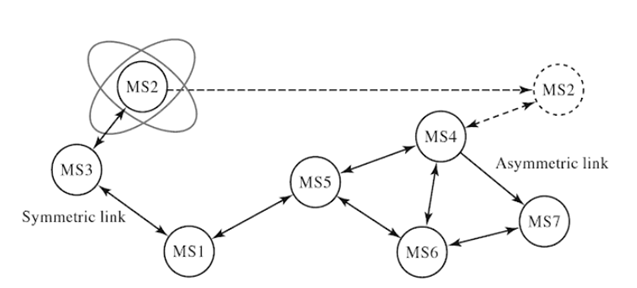86
Mobile Adhoc Network (MANET)
- A MANET consists of a number of mobile devices that come together to form a network as needed, without any support from any existing internet infrastructure or any other kind of fixed stations.
- A MANET can be defined as an autonomous system of nodes or MSs(also serving as routers) connected by wireless links, the union of which forms a communication network modeled in the form of an arbitrary communication graph.
- This is in contrast to the well-known single hop cellular network model that supports the needs of wireless communication between two mobile nodes relies on the wired backbone and fixed base stations.
- In a MANET, no such infrastructure exists and network topology may be changed dynamically in an unpredictable manner since nodes are free to move and each node has limiting transmitting power, restricting access to the node only in the neighboring range.
- MANETs are basically peer-to-peer, multi-hop wireless networks in which information packets are transmitted in a store and forward manner from a source to an arbitrary destination, via intermediate nodes as given in the figure:

- As nodes move, the connectivity may change based on relative locations of other nodes. The resulting change in the network topology known at the local level must be passed on to other nodes so that old topology information can be updated.
- For example, as MS2 in the figure changes its point of attachment from MS3 to MS4, other nodes that are part of the network should use this new route to forward packets to MS2. In the figure, we assume that it is not possible to have all nodes within each other’s radio range. In case all nodes are closed by within each other’s radio range, there are no routing issues to be addressed.
- In figures raise another issue, that of symmetric and asymmetric (bidirectional) and asymmetric (unidirectional) links. Consider symmetric links with associative radio range; for example, if MS1 is within radio range of MS3, then MS3 is also within radio range of MS1. The communication links are symmetric. This assumption is not always valid because of differences in transmitting power levels and the terrain. Routing in asymmetric networks is relatively hard task. In certain cases, it is possible to find routes that exclude asymmetric links, since it is cumbersome to find the return path. The issue of efficient is one of the several challenges encountered in a MANET.
- The other issue is varying the mobility patterns of different nodes. Some other nodes are highly mobile, while others are primarily stationary. It is difficult to predict a node’s movement and direction of movement and numerous studies have been performed to evaluate their performance using different simulators.
Characteristics of MANET
Some characteristics of adhoc network are as follows:
- Dynamic topologies: nodes are free to move arbitrarily; thus the network topology may be changed randomly and unpredictably and primarily consists of bidirectional links. In some cases where the transmission power of two nodes is different, a unidirectional link may exist.
- Bandwidth-constrained and variable capacity links: wireless links continue to have significantly lower capacity than infrastructure networks.
- Energy-constrained operation: some or all of the MSs in a MANET may rely on batteries or other exhaustible means for their energy. For these nodes or devices, the most important system design optimization criteria may be energy conservation.
- Limited physical security: MANETs are generally more prone to physical security threats than wire line networks. The increased possibility of eavesdropping, spoofing, and denial of services (DoS) attacks should be considered carefully. To reduce security threats, many existing link security techniques are often applied within wireless networks.
Applications of MANET
Some specific applications of ad hoc networks include industrial and commercial applications involving cooperative mobile data exchange. There are many existing and future military networking requirements for robust, IP-compliant data services within mobile wireless communication networks, with many of these networks consist of highly dynamic autonomous topology segments. Advanced features of Mobile ad hoc networks, including data rates compatible with multimedia applications global roaming capability, and coordination with other network structures are enabling new applications.
- Defense applications: Many defense applications require on the fly communications set-up, and ad hoc/sensor networks are excellent candidates for use in battlefield management.
- Crisis management applications: These arise, for example, as a result of natural disasters in which the entire communication infrastructure is in disarray. Restoring communications quickly is essential.
- Telemedicine: The paramedic assisting the victim of a traffic accident in a remote location must access medical records (e.g. X-rays) and may need video conference assistance from a surgeon for an emergency intervention. In fact, the paramedic may need to instantaneously relay back to the hospital the victim’s X-rays and other diagnostic tests from the site of the accident.
- Tele-geoprocessing application: The combination of GPS, GIS (Geographical Information Systems), and high-capacity wireless mobile systems enables a new type of application referred to as tele- geo processing.
- Virtual Navigation: A remote database contains the graphical representation of building, streets, and physical characteristics of a large metropolis. They may also “virtually” see the internal layout of buildings, including an emergency rescue plan, or find possible points of interest.
- Education via the internet: Educational opportunities available on the internet or remote areas because of the economic infeasibility of providing expensive last-mile wire line internet access in these areas to all subscribers.
- Vehicular area network: This a growing and very useful application of adhoc network in providing emergency services and other information. This is equally effective in both urban and rural setup. The basic and exchange necessary data that is beneficial in a given situation.
Next TopicRouting
